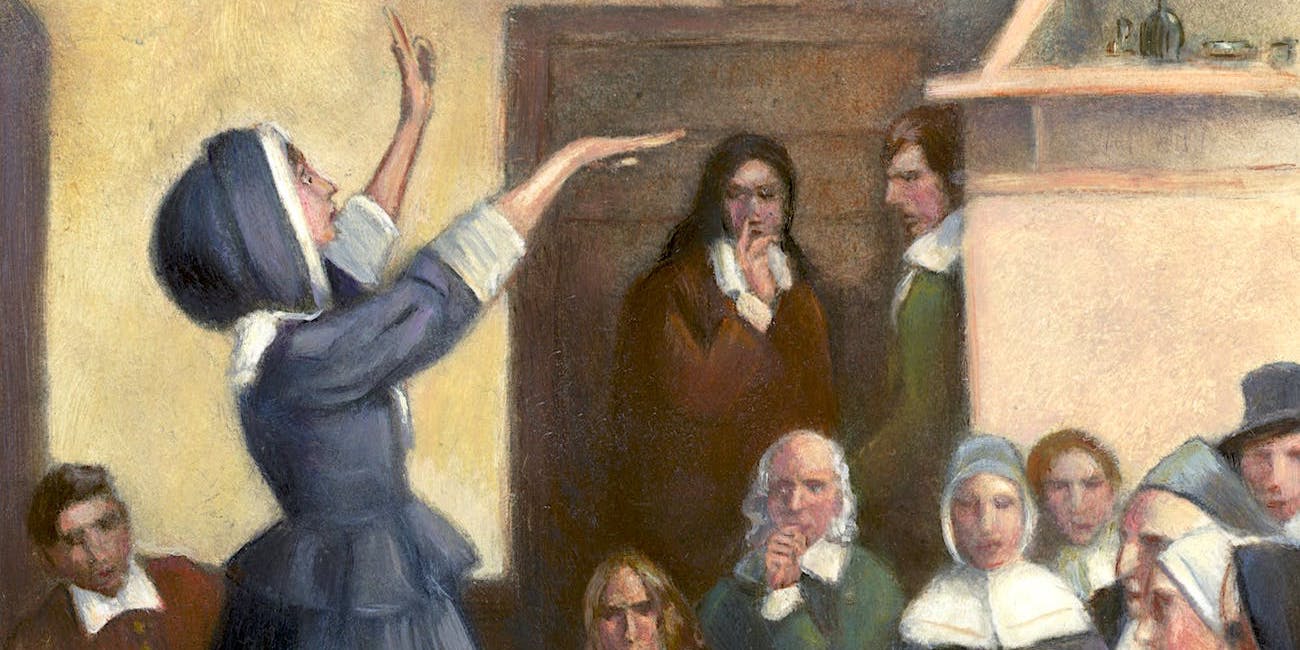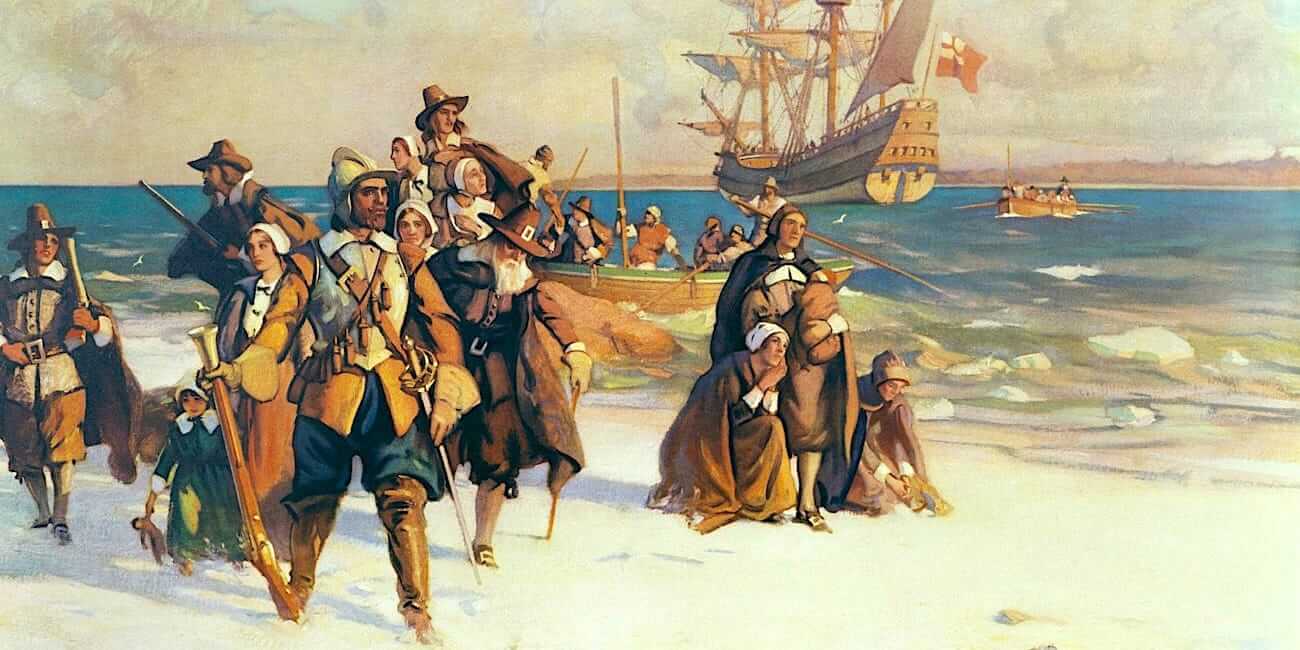Jane Hawkins
In 1629 crowds of up to 200 people gathered at the house of a St Ives woman, Jane Hawkins. They assembled to witness three days and three nights of prophetic rhyming. These were times of great religious upheaval. Any strange behaviour could result in accusations of witchcraft. The authorities executed the
Witches of Warboys 30 years before.
Read on to learn how Jane came into conflict with the Bishop of Lincoln. Also how she was part of the Puritan Great Migration to America.
Prophetic rhyming
Jane was born in St Ives in 1587. Her maiden name was Angell. In the uncertain spelling of the time, her first name was also spelt Jaine. She married Richard Hawkins in 1602. They had seven children. Jane worked as a pedlar, travelling from place to place selling small items.
In 1629 Jane started to 'prophesy'. A crowd of 200 gathered to witness as Jane continued her prophetic rhyming for three days and nights. Job Tookey, the vicar of St Ives from 1612, attended and arranged for a scholar to copy out the thousands of verses. The aim was to produce them in print.
Although she made a strong local impression, Jane was on dangerous ground. The Church of England forbade women from preaching in churches. If her possession was demonic, the authorities could try Jane for witchcraft.
The Bishop of Lincoln was unenthusiastic about events in St Ives. He referred to Jane as 'a witty crafty baggage'. No wonder. Jane strengthened the ministry of Job Tookey. But she also predicted the downfall of the bishops.
The Bishop attended one of Jane's sessions in disguise. He had the written verses seized. He suspended Job Tookey when Job refused to abandon Jane. The authorities isolated Jane. Jane's followers turned on her. Job Tookey was forced to make a written acknowledgement that she was an imposter. He was moved on to another parish by 1631.
The Puritan Great Migration
Puritans sought to 'purify' the Church of England of Roman Catholic practices. This theme ran strong in St Ives, even to more recent times. In the 1800s
Read Adams had explosive disagreements with the local vicar on the topic. In 1919 there was a cry of 'no popery' at a
meeting to organise the St Ives War Memorial.
Jane was a Separatist Puritan. She believed in forming an independent local church. The religious climate had taken a turn for the worse in 1625 when
Charles I became king. He had a Catholic wife and favoured the Catholic religion. Hostility towards Protestants, and Puritans in particular, increased. The
Archbishop of Canterbury launched a religious tyranny on Puritans.
Jane, her husband and seven children were part of the
Puritan Great Migration. It started with the landing of the
Mayflower in New England in 1620. By 1635 Jane and family had settled in
Boston, New England. They arrived just 5 years after Boston was established by Puritan colonists.
Religious upheaval was no less active in New England.
Anne Hutchison was a leader of the
Antinomians and Jane associated with the sect. The Antinomians 'heretical' beliefs and preaching caused controversy with the dominant Puritans.
Jane became a well-known midwife and healer. Anne Hutchinson was also a midwife. In 1637 Anne and Jane attended
Mary Dyer, also an Antinomian, in her labour. The baby was stillborn and deformed. The authorities could blame the birth on Anne's and Jane's heretical beliefs. They buried the child in secret. English custom allowed a midwife to make a burial in private, but not in secret.
Five months later the authorities found out about the burial. They declared the birth of a 'monster' was a sign of God's displeasure with the Antinomians. The authorities accused Jane of 'familiarity with the Devil' when she lived in St Ives. They suspected Jane of involvement in witchcraft.
Jane had to stop practising her trade. She had the choice of expulsion from the Massachusetts Colony or a severe whipping. Two of her sons took Jane away to follow Anne Hutchinson and Mary Dyer to Rhode Island. Returning to Boston in 1641, the authorities banished her again.
Jane was sailing close to the wind. Her case was among the earliest cases of witchcraft in New England. A few years later, when anti-witch hysteria was on the increase, execution was the more likely outcome.
The two women Jane associated with suffered early deaths. Local native Indians killed Anne Hutchinson and most of her family in 1643. Execution by hanging for her beliefs was Mary Dyer's fate in 1660.
Jane Hawkins died in 1656 at Portsmouth, Newport, Rhode Island, aged 69 years.




Fascinating; did any of her verse survive (other than one publishe in Early Modern Women's Poetry"?
ReplyDeleteNone that I'm aware of, David. Glad you enjoyed the article.
DeleteThis individual just showed up on my Ancestry. Interestingly I am a prophetic poet and teach this work. I just landed in Europe (from western Canada) and will be in Glastonbury. Might have to make a trip to Saint Ives
ReplyDeleteVisit St Ives & you won't be disappointed! Currently, we're surrounded by water. A bit early this year, but the point of the flood meadows that surround our beautiful little town. You might wish to read more of the content on the SI100YA website to get a feel for the place.
Delete